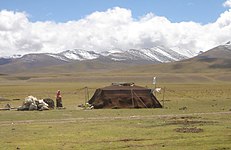Prossinia
Republic of Prossinia Republikinn Prossinië ᠫᠷᠣᠰᠰᠢᠨᠢᠶᠠ | |
|---|---|
| Capital | Yakatra |
| Largest largest city | Joblianja |
| Official languages | Prossinian, Karkut |
| Demonym(s) | Prossinian |
| Government | Unitary parliamentary constitutional republic |
| Markus Nalstrayva | |
| Gertrev Jasko | |
| Sonja Lorechev | |
| Legislature | Parliament |
| Establishment | |
• Under Karkut Empire | 1250-1320 |
• Empire of Prossinia | 1530-1815 |
| 1815 | |
• Revolt of 1864 | 1864 |
• Republic of Prossinia | 1864 |
| Area | |
• | 2,234,899 km2 (862,899 sq mi) |
| Population | |
• 2021 estimate | 35,789,000 |
• 2016 census | 33,488,989 |
| GDP (PPP) | 2021 estimate |
• Total | $1.2 trillion |
• Per capita | $24,244 |
| GDP (nominal) | 2021 estimate |
• Total | $1.6 trillion |
• Per capita | $22,650 |
| Gini (2020) | medium |
| HDI (2020) | very high |
| Currency | Prossinian Dinar (PRD) |
| Date format | yyyy/mm/dd |
| Driving side | right |
| Calling code | +677 |
| Internet TLD | .ps |
Prossinia (Prossinian: Prossinië), officially the Republic of Prossinia (Prossinian: Republikinn Prossinië), is a landlocked country located in the continent of North Utopia. It is bordered by Regmotto, Karkutia, Narvistan, Danitriss, and East Cammotand. Prossinia covers two million kilometres squared which includes plains, arid steppe and tundra in the north, the majority live in the centrak low lying plain. Prossinia is a unitary parliamentary constitutional republic. Prossinia has made a slow recovery in both demographics and economy since the end of the expansionist era. Prossinia is a member of the Universal Pact and Utopian Union after a referendum in 2021.
History
Under Karkut Empire
Early Kingdom of Prossinia
Empire of Prossinia
Northern Exploration
Revolts of 1815
Revolts of 1864 and Creation of The Prossinian Republic
Socialist Republic of Prossinia
Republic of Prossinia(1983-present)
Geography
Prossinia is a vast country covering a total of 2,234,899 km squared. It is bordered to the south by Karkutia, to the north by Regmotto, to the west by Narvistan and to the east by East Cammotand. Prossinia lies north of the most northern portion of the great utopian steppe. The ‘’Jestaany ‘’ mountains dominate southern Prossinia and make up the most sparsely populated area in the country. The cemtre of Prossinia is often called the ‘’Prevalka’’ region. It is a region where rivers and lakes dominate a landscape of rolling hills and plains. It is the most densely populated part of Prossinia. A large portion of the northwest of Prossinia is made up of woodland and plains which are important for agriculture. The east of Prossinia is home to several small mountain ranges as is the north, the north east is variably mountainous. The centre of Prossinia has always been the country’s heartland where waterways led to the development of Prossinian agriculture and eventually industry. Of Prossinia’s rivers the ‘’Ydstra’’ is the most important as it flows through the most populated part of Prossinia including the capital, Yakatra. It is the longest river in the country and it is so important that it is represented on the national flag.
Prossinia has many impressive lakes. The deepest and largest of these is lake Baiak in the northwest. Other large lakes include Joblianja where the city of Joblianja lies on. There are more than 1,600 lakes in the centre of the country.
Climate
Politics
Prossinia is a unitary parliamentary republic. The President of Prossinia acts as the head of State. The presidency is a purely symbolic role, nevertheless they are elected every five years. The President appoints the Prime Minister is the head of the executive government. The Prime Minister is voted in during general elections and they and their cabinet form the government. Legislative power presides in the National Assembly of Prossinia which is a unicameral legislature comprised of 282 members. The powers of the National Assembly include passing laws, approving cabinets, granting confidence, removing individual ministers or forcing the whole executive to resign through motions of no confidence. Prossinia has had a long-standing Democratic tradition which carries through to the current age we live in. Prossinia is a multiparty democracy. Two parties the People’s Social Party a centre-left party and the Liberal Democratic Alternative Party a centre-right party have dominated Prossinian politics since the late 1930’s. The People’s Social Party ruled Prossinia successively from the early 1970’s to the 1990’s and recently came into power again in 2017. The Liberal Democratic Alternative ruled Prossinia for brief spells in the 1930’s, 40’s and 60’s before becoming the dominant force of Prossinian politics in the late 1990’s and 2000’s. There are several smaller parties and fringe parties that occasionally make coalitions with the two main parties such as the current government which is a coalition between the People’s Social Party, the Prossinian Green Party and the party known as The Left. The Prossinian judiciary is organised so that the highest court is the Supreme Court followed by regional courts. The judiciary of Prossinia is one of the most independent in the world and stands out in several polls in that fashion.






